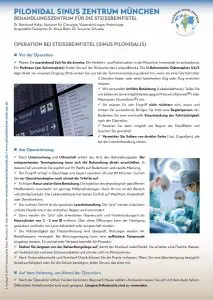Wie minimal-invasive Eingriffe die Steißbeinfistel-OP revolutionieren
Diagnose Steissbeinfistel: Sie haben Beschwerden im Steißbeinbereich oder der Gesäßfalte und nach einem Arztbesuch oder eigener Recherche die wahrscheinliche Ursache gefunden: eine Steißbeinfistel (Sinus pilonidalis). Der erste Schock sitzt tief, als Ihr Arzt sagt: „Das muss operiert werden.“ Und dann die ernüchternde Erklärung: Die Fistel wird bis auf den Knochen ausgeschnitten, und die Wunde muss offen zuheilen – eine Prozedur, die sechs Wochen bis drei Monate dauern kann.
Zu Hause angekommen, lesen Sie Berichte in Internetforen: ausbleibende Wundheilung, schmerzhafte Wundpflege, wiederkehrende Fisteln. Ihre Angst steigt. Sie beginnen, nach Alternativen zu suchen und stoßen auf zahlreiche minimal-invasive Operationstechniken, die vielversprechend klingen. Doch welche ist die beste Methode für Sie?
In diesem Artikel schaffen wir Klarheit über zeitgemäße Operationstechniken bei Sinus pilonidalis. Wir erklären die verschiedenen Methoden verständlich und zeigen Ihnen den Weg zu einer schonenden und effektiven Behandlung, damit Sie schnell und schmerzfrei wieder in Ihren Alltag zurückkehren können.
Obwohl ein Sinus pilonidalis in der Regel nicht gefährlich ist, können die damit verbundenen Symptome das Leben enorm einschränken. Große Rotationslappenverfahren sind ... bei leichteren Erkrankungen ein Overkill und ... führen zu einer komplexen Wunde, die die Situation meist schlimmer macht als die ursprüngliche Erkrankung.
Johnson, Eric K. "Expert Commentary on Pilonidal Disease: Management and Definitive Treatment." Diseases of the Colon & Rectum 61.7 (2018): 777-779. Cleveland Clinic, Cleveland, Ohio, U.S.A.
Dies wollen wir unbedingt vermeiden. Bei uns sind Sie in guten Händen, denn wir sind mit allen gängigen Operationstechniken beim Sinus pilonidalis vertraut und stehen Ihnen mit professionellem Rat zur Seite. Unsere minimal-invasive Methode basiert auf der Lord -Bascom I (Pit Picking) Technik. Seit 2004 haben wir diese schonenden Verfahren kontinuierlich weiterentwickelt und können heute damit hervorragende funktionelle und ästhetische Ergebnisse erzielen.
Die Vorteile unseres Behandlungskonzepts sind:
- Untersuchung, Beratung und Operation an einem Tag
- Behandlung in örtlicher Betäubung, keine Vollnarkose erforderlich
- Durchführung in der Praxis, kein Krankenhausaufenthalt notwendig
- Wesentlich kleinere Wunden
- Schnellere Wiederherstellung von Arbeits- und Sportfähigkeit
- Erhaltung der normalen Körperkontur und unauffälligere Narben
Auf dieser Seite erläutern wir die Varianten der Pit Picking Operation aus pathophysiologischer und operationstechnischer Sicht. Auf der Seite über den Behandlungsablauf bei uns in der Praxis erfahren Sie die praktischen Aspekte.
Die "einfache" Methode: Pit Picking – A Simple Treatment
Der englische Chirurg Peter Lord publizierte 1965 im British Journal of Surgery eine neue Behandlungsmethode. Diese Pit Picking genannte OP bei Steißbeinfistel ist so einfach und wirksam, daß man es kaum glauben möchte.
Als erster erkannte er die entscheidende Bedeutung der eingewachsenen Haare. Mit seiner Technik der Entfernung der betroffenen Haarwurzeln entwickelte er eine Alternative zur üblichen Radikaloperation und begründete damit eine neue Ära in der Behandlung der Steißbeinfistel. Für die Reinigung des Fistelkanals empfahl er eine Rundbürste.
Darüber hinaus betonte Lord die Wichtigkeit der Haarentfernung für die Nachbehandlung. Er empfahl die Elektro-Epilation oder Rasur, Laser zur Haarentfernung gab es damals noch nicht.
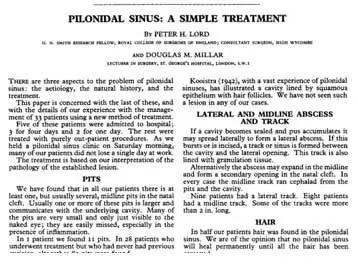
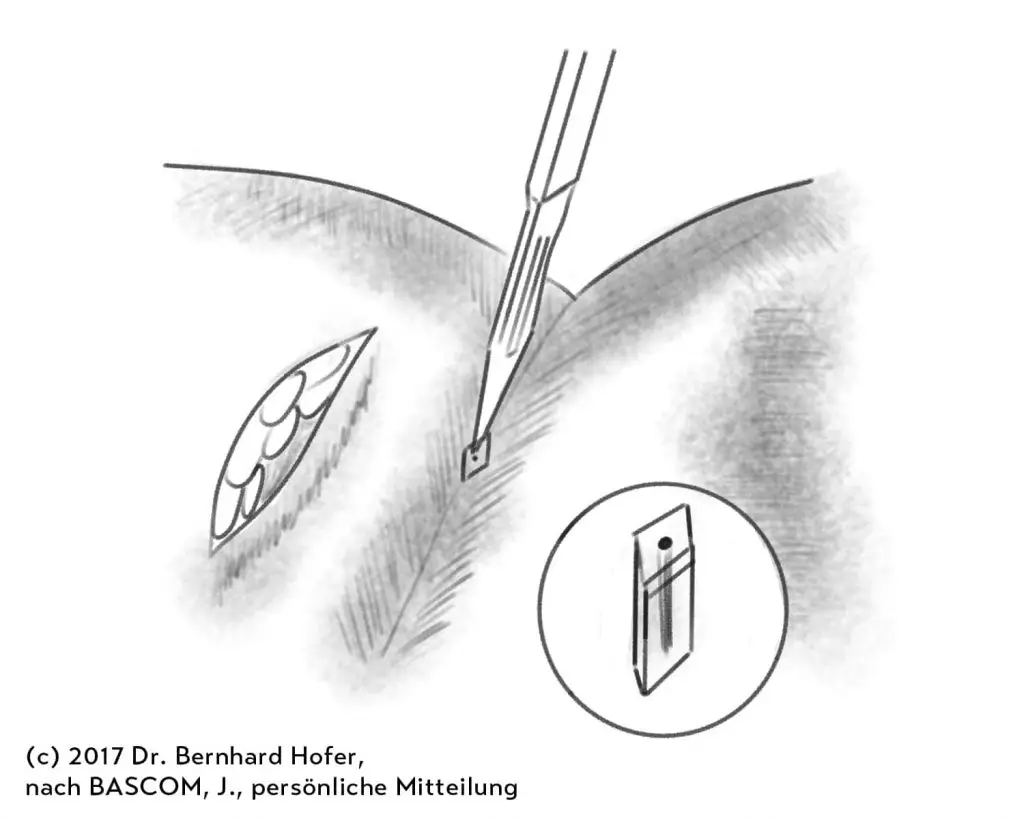
Pit Picking = Follicle removal
Zunächst fand die bahnbrechende „Lord-Millar-Prozedur“ erstaunlicherweise nur wenig Beachtung. Erst John Bascom (Oregon, U.S.A.) sorgte für die weltweite Verbreitung der fortschrittlichen Technik, die er „follicle removal“ nannte. Mit großem Engagement unterstützte er weltweit Chirurgen beim Erlernen dieser Technik.
Mit der Erfahrung aus über 4500 Operationen habe ich die Technik ständig weiterentwickelt. Expertise und technologischer Fortschritt (Lupenbrille, 4MHz-Radiofrequenz-Chirurgie, Laser-Chirurgie und die besten Instrumente aus verschiedenen Fachrichtungen wie ästhetischer Chirurgie, HNO und Kieferchirurgie) erlauben es, fast jede Steißbeinfistel minimal-invasiv zu behandeln. Das Pit Picking Prinzip läßt sich auch beim Rezidiv (Rückfall) nach herkömmlicher Operation anwenden: Identifikation der Eintrittspforte, Entfernung der Fistel über diese schon vorhandene Öffnung und Vermeidung des erneuten Einwachsens von Haaren durch Rasur und Laserepilation.
Nach der Beschreibung von Lord und Bascom werden bei diesem Eingriff die Pits ausgeschnitten als Hautzylinder von der Größe eines Reiskorns. Wir verwenden dafür dermatologische Biopsiestanzen von 2 – 4 mm. Die eingeschlossenen Haare werden mit einem feinen Klemmchen herausgezogen, der Fistelgang gesäubert unter Belassen der Fistelkapsel. Manche Operateure setzen zusätzlich seitlich einen 1 – 2 cm langen Längsschnitt für den Sekretabfluß, die Entlastungsinzision. Die Entfernung des Fremdkörpers beseitigt den Grund der chronischen Entzündung und die Fistel kann heilen. Hautfäden sind nicht erforderlich und würden unter Umständen die Heilung sogar stören.
Fazit Pit Picking "klassisch"
- bei geringer Vernarbung der Steißbeinfistel
- bei nicht voroperierten Steißbeinfisteln
- gute Alternative bei jungen Patienten < 14 Jahre
Pro
- kleinstmöglicher Eingriff
- ambulant durchführbar
- kurze Behandlungsdauer 10 – 30 min
- kurze Heilungsdauer 2 – 3 Wochen
- Heilungsrate bis 70%
- wiederholt durchführbar, Alternativen bleiben möglich
Contra
- bei stark vernarbten Fisteln weniger erfolgversprechend
- Säuberung des Fistelgangs manchmal unvollständig
- Rezidivrate bis 30 %
- verhärteter Fistelgang oft spürbar trotz Abheilung der Öffnungen
Laser Operation (SiLaC – Sinus Laser Ablation of the Cyst)
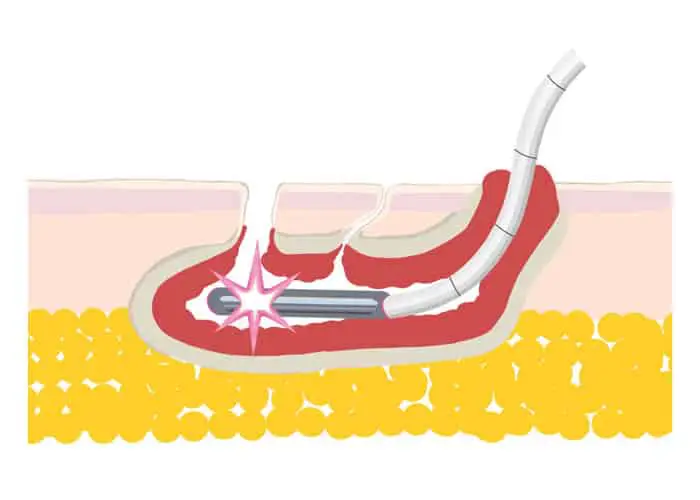
In ausgewählten Fällen war ein erneutes Pit-picking bei Rezidiv erfolgreich. Dennoch konnte die Erfolgsrate der Pit-picking Operation von maximal 70 % nicht restlos überzeugen. Im Jahr 2011 stellten Wilhelm und 2013 Giamundo die FiLaC Lasertechnik zur Behandlung von Analfisteln vor.
Der Gedanke lag nahe, die Lasersonde auch für die Steißbeinfistel zu verwenden. Und in der Tat ließ sich damit die Erfolgsrate auf über 80 % steigern.
Die Laserbehandlung ist als Zusatzmaßnahme zum Pit Picking zu sehen. Entfernung der Pits und Säuberung des Fistelgangs erfolgen identisch. Danach wird die Lasersonde mehrere Male unter Energieabgabe durch den Fistelkanal gezogen, sodass die Innenschicht der Fistelkapsel ausgebrannt wird und die Kapsel schrumpft.
Fazit FiLaC / SiLaC
- bei langen Fistelgängen
- bei zahlreichen Fistelöffnungen
- bei Präferenz des Patienten auf schnellstmöglicher Rekonvaleszenz („downtime“)
- zur Symptomlinderung bei schwierig zu heilenden Mehrfachrezidiven und Akne inversa
Pro
- Alle Vorteile des Pit-picking
- Verbesserte Heilungsrate bis 80 %
- Schnelle Rückbildung von Blutungen und Sekretabsonderung
Contra
- vermehrte Schwellung in den ersten Tagen nach OP
- Selbstzahlerleistung
- Fistelgang oft spürbar trotz Abheilung der Öffnungen
„Pit Picking 2.0“ Minimal-invasive „tubuläre“ Ausschälung des Fistelgangs
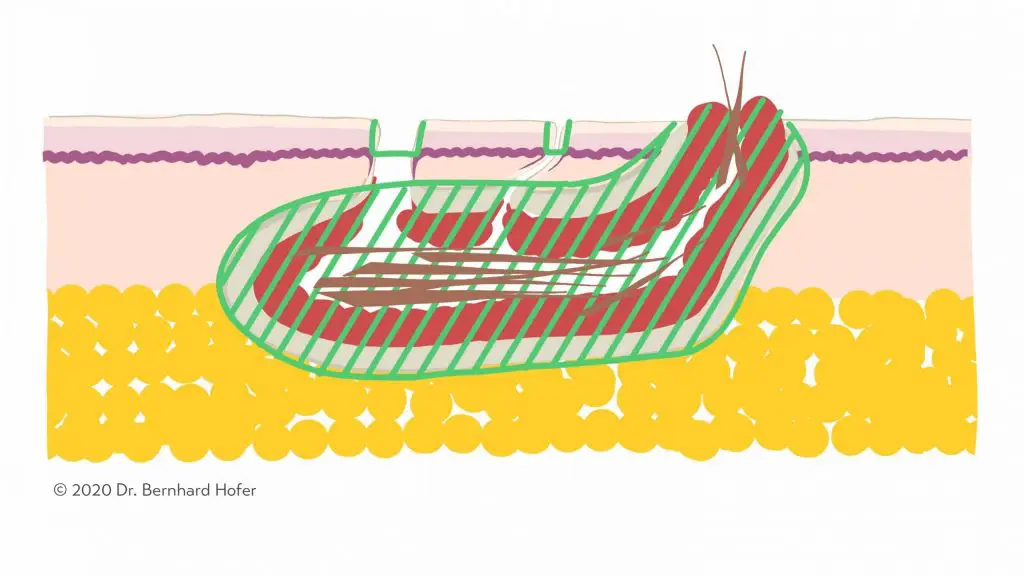
Was ist an Pit Picking und FiLaC zu verbessern?
Ziel ist es, die vollständige Entfernung der eingeschlossenen Haare zu garantieren.
Seit langem weiß man, dass sich im Hohlraum einer Steißbeinfistel nicht immer Haare finden.
Bei dieser auch als “empty nest” – leeres (Haar-)Nest bezeichneten Konstellation zeigt die mikroskopische Untersuchung oft in die Wand der Fistelkapsel integrierte Haare – eine mögliche Ursache für das Rezidiv nach Pit Picking.
Darüber hinaus führt die mechanische Irritation durch die knorpelartig verhärtete Fistelkapsel zu Beschwerden. Mit der Entfernung der Fistelkapsel wird Sitzen auf harter Unterlage wieder bequem.
Evolution der Operationstechnik
Gibt es einen Mittelweg zwischen “Ausbürsten” des Gangs beim pit-picking und der vollständigen Ausschneidung?
Der erste Gedanke war ein Hautschnitt im Fistelverlauf mit abschließender Hautnaht. Bei seitlichen oder schräg verlaufenden Fisteln gelingt dies sehr gut. Verläuft die Fistel genau in der Mitte, hat man damit wieder das Problem der Naht an ungünstiger Stelle.
Mit zunehmender Erfahrung wurde der notwendige Schnitt immer kürzer. Die tubuläre Fistulektomie (schlauchförmige Fistelausschneidung), auch Sinusektomie genannt, löst die obengenannten Probleme.
Lupenbrille, Tumeszenz-Anästhesie und der Laser 470 nm bieten höchst Präzision und Schmerzfreiheit. Die Sinusektomie ist deshalb die Standardmethode in meiner Praxis.
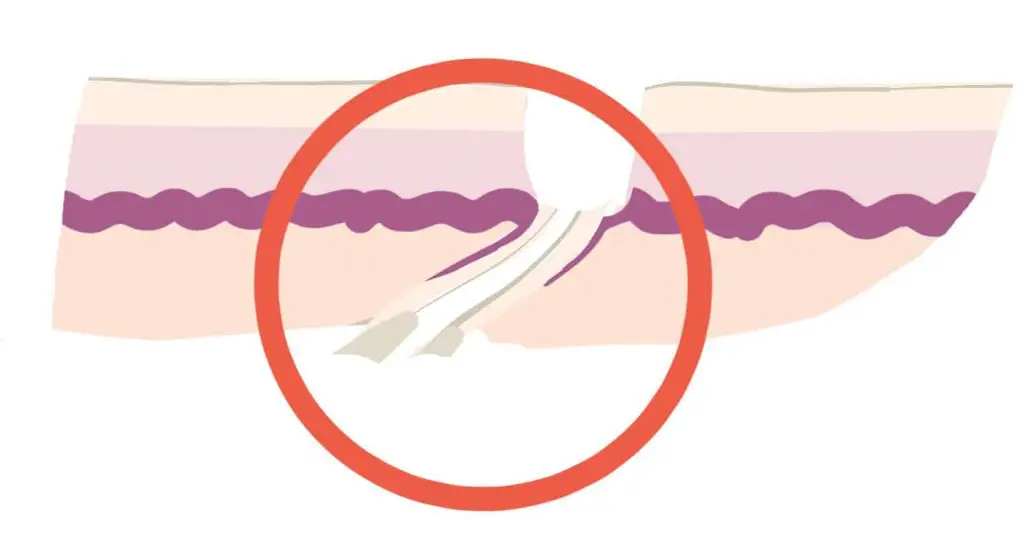
Pro
- Vollständige Fistelentfernung ohne große Wunde
- Heilungsrate bis über 90 %
- Beseitigung oder zumindest Verminderung schmerzhafter Verhärtungen
- Auch beim Rezidiv anwendbar
- Ambulante Operation möglich
- Kurze Arbeitsunfähigkeit
- Keine körperliche Schonung notwendig
- Kostenübernahme durch alle Krankenkassen
Contra
- Nur wenige Ärzte in Europa haben ausreichende Erfahrung
- Längere OP Dauer 30 – 120 min
- Innere Wundhöhle entspricht dem Volumen der entfernten Fistel
- Anfänglich Absonderung von Wundflüssigkeit
- Anfänglich Schmerz bei Belastung
* SPA = Spinalanästhesie, Rückenmarksnarkose, ITN = Intubationsnarkose, Vollnarkose, LA = Lokalanästhesie, örtliche Betäubung.
Tabelle: Übersicht über die gebräuchlichsten OP Techniken bei Steißbeinfistel
Unsere Empfehlungs-Ampel
In keinem Fall soll die folgende Darstellung als Anleitung für eine unkritische Selbstbehandlung dienen. Die Empfehlungen folgen nach bestem Wissen eigener Erfahrung und ausgewählten Publikationen. Eine systematische Analyse verfügbarer Studien stellen sie nicht da. Fragen Sie in jedem Fall vor der Anwendung einen in der Wundbehandlung erfahrenen Facharzt.
Noch Fragen?
Sie möchten sich genauer informieren, wie eine Behandlung bei uns ablaufen könnte? Häufige Fragen haben wir gleich hier in den FAQ beantwortet und auch unser Chat kann oft weiterhelfen (Klicken Sie auf das Symbol mit den zwei Sprechblasen rechts unten!)
Ansonsten haben wir eine neue Seite aufgebaut, die den gesamten Behandlungsablauf genau schildert.
Die pit-picking Operation kann definitionsgemäß nur durchgeführt werden, wenn sich "pits", auch Primärfistel oder Porus genannt, finden, also in erster Linie bei der noch nicht voroperierten Pilonidalfistel. Ein solcher "pit" kann aber auch bei der Erstoperation übersehen worden oder neu entstanden sein und damit einen Rückfall (Rezidiv) verursachen. Und schließlich lässt sich der Grundgedanke des pit-picking, die Heilung der Fistel durch Ausschaltung einer Eintrittspforte, auch bei den häufigen Typ IV Pilonidalfisteln umsetzen.
Beim klassischen pit-picking wie beschrieben von Lord und Bascom wird der Fistel Schlauch nicht entfernt, sondern lediglich von den eingeschlossenen Haaren gesäubert. Durch Wegfall dieses Entzündungsreizes kann das Gewebe im Verlauf eine gewisse Normalisierung erfahren, ganz verschwindet die Verhärtung in der Regel nicht. Auch deshalb kombinieren wir das pit-picking mit der Sinusektomie, also dem Ausschälen des Fistelgangs unter der Haut.
Grundsätzlich lässt sich dieses Risiko tatsächlich nicht ganz ausschließen, wenn keine histologische Untersuchung erfolgen kann. Bösartige Steißbeinfisteln sind glücklicherweise extrem selten und meist auch durch andere Befunde auffällig.
Dieser Eingriff wird derzeit ausschließlich von spezialisierten Fachärzten angeboten, überwiegend aus dem Fachgebiet der Allgemein- und Viszeralchirurgie, aber auch der Dermatologie. Bei der Auswahl des Arztes sollte auch die Frage erlaubt sein, wie oft der Kollege solche minimal-invasiven Eingriffe durchführt.
Die klassische Pit Picking Operation kann immer in örtlicher Betäubung (Lokalanästhesie) erfolgen. Eine Vollnarkose würde man nur ausnahmsweise bei sehr jungen oder besonders besorgten Patienten bevorzugen.
Ja, für diese Operation benötigt man keinen Krankenhausaufenthalt.
Ja, bei unserer Technik des Pit Picking wird die Fistel über die kleinen Öffnungen chirurgisch entfernt. Diese "Excision" einer Steißbeinfistel gehört in Deutschland zu den Leistungen der gesetzlichen Krankenversicherung.
Privatpatienten und Selbstzahler sollten mit einem Betrag zwischen 700 und 1200 € bei ambulanter Behandlung in Lokalanästhesie rechnen. Die Kosten hängen dabei von Komplexität der Fistel und Zeitaufwand ab. Einen Überblick über Erstattungsfähigkeit gibt unsere Seite Behandlungskosten.
Ja, wenn der Operateur Erfahrung mit der örtlichen Betäubung hat und sich etwas Zeit nimmt, treten keine Schmerzen während der Operation auf. Wir verwenden die sogenannte Tumeszenz-Anästhesie, mit der auch große Operationsgebiete zuverlässig betäubt werden können.
Das "Picken der Pits" (sparsame Ausschneiden der vergrößerten Haarwurzeln) und Säubern des Fistelgangs dauert manchmal nur 10-15 Minuten. Soll der Fistelgang zusätzlich mit Laser behandelt (SiLaC) oder entfernt werden (Sinusektomie), sind Operationszeiten zwischen 30 und 60 Minuten zu erwarten.
Ja, Sie dürfen jede Position einnehmen, die ihnen angenehm ist. Insbesondere direkt nach der Operation ist das sogar hilfreich, da eine sanfte Kompression vorbeugend gegenüber Nachblutungen wirkt.
Schwerwiegende Komplikationen sind nicht zu erwarten. Am Operationstag sind Nachblutungen möglich, die aber nur sehr selten einer ärztlichen Blutstillung bedürfen. Wundheilungsstörungen, Wundinfektionen und das erneute Auftreten einer Fistel nach Abheilung (Rezidiv) betreffen etwa 10 % der Patienten (bei Pit Picking und Sinusektomie) bis 30 % (bei alleinigem Pit Picking).
Nach Pit Picking und Sinusektomie sind grundsätzlich ab dem Folgetag der Operation alle Aktivitäten erlaubt. Die Heilung wird durch Sport oder Berufstätigkeit nicht beeinträchtigt.
Leichte bis mittelstarke Schmerzen beim Sitzen im Büro oder Auto können eine Arbeitsunfähigkeit begründen, selten länger als 2 Wochen.
Die Zeit, bis alle Wunden abgeheilt sind, ist natürlich sehr stark abhängig von dem Ausgangsbefund. Im Durchschnitt sollte man mit 6 Wochen rechnen. Sind die Wunden auch nach 8 Wochen nicht verheilt, ist eine Kontroll-Untersuchung bei uns zu empfehlen.
Äußerlich sollten alle Wunden geschlossen, die Farbe der Narben nicht mehr violett, sondern hautfarben bis weiss sein. Eine leichte Verhärtung im ehemaligen Fistelverlauf ist normal, stärkere Schwellungen sind verdächtig auf ein Problem. Wesentliche Schmerzen sollten nicht mehr bestehen. Die beste Beurteilung erlaubt eine Ultraschall-Untersuchung.
Ja, körperliche Aktivität hat keinen negativen Einfluss auf die Wundheilung.
Zum Thema Baden und Duschen gibt es viele Meinungen. Die offiziellen Richtlinien des Robert-Koch-Instituts würden davon abraten und empfehlen die Verwendung eines Bakterienfilters (z.B. Germlyser® D) beim Duschen. Wir haben aber noch nie negative Folgen gesehen, wenn unsere Patienten mit Wasser von Trinkwasserqualität duschen oder im Meer, See oder im Schwimmbad baden gehen (Europa).
Das häufigste Problem nach allen Operationen bei Steißbeinfistel ist das Eindringen von Haaren in die Wunde. Es ist also sorgfältig die Umgebung der Wunde zu rasieren. Lose, abgebrochene Haare vom Kopf sollten ebenfalls immer sofort entfernt werden. Für die Langzeitprognose bietet die Laserepilation Vorteile.
Es hat sich bewährt, einen Verband aus zusammengelegten oder gerollten ES-Kompressen 10 x 10 in der Gesäßfalte vorzulegen und mit einem Tape- Streifen, zum Beispiel Fixomull® zu befestigen. Bei kleineren Wunden reicht manchmal auch ein Fertigpflaster oder eine handelsübliche Slipeinlage, die das Wundsekret aufsaugt. Aufwändiges Verbandsmaterial (Silber, Alginat, Hydrokolloid) ist nur bei Problemen im Heilungsverlauf gelegentlich sinnvoll.
Bei normalem Verlauf ist das nicht zwingend erforderlich. Eine Übersicht über Salben und Antiseptika finden Sie auf unserer Seite zur konservativen Behandlung.
Dr. Bernhard Hofer und Florian Liebl
Fachärzte für Viszeralchirurgie und Proktologie – PartG mbB
Brienner Str. 13, D-80333 München

Mit dem Laden der Karte akzeptieren Sie die Datenschutzerklärung von Google.
Mehr erfahren
Kontakt:
Montag bis Freitag
08.00 – 13.00
14.00 – 18.00
Samstag, Sonntag, Feiertag geschlossen
Beachten Sie auch unsere Hinweise im Titel dieser Website und auf unserer Telefonansage.
© 2024 Proktologische Praxis München

